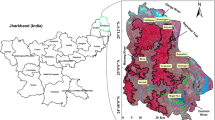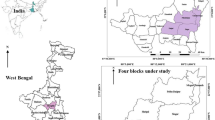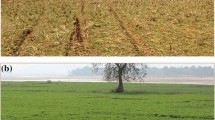Abstract
Crop acreage estimation is an essential component for forecasting crop production. Menthol mint acreage estimation is a necessity as the crop production data change every year due to fluctuations in the market prices of menthol mint oil; hence, the rate available to farmers also changes every year. These acreage estimation studies would be helpful in reducing the uncertainties of menthol mint production as lower price results in low production and high price results in higher production next year. Thus, it in turn would help in stabilizing the market prices. Nowadays, remote sensing technologies due to their availability and adaptability are being widely used for crop acreage estimation nationally and internationally. This study focuses on menthol mint crop acreage estimation in the Barabanki district of Uttar Pradesh, India, using 2017 Sentinel-2A satellite data. Adaptive maximum likelihood classification algorithm was applied after intensive ground survey to obtain reliable menthol mint crop acreage estimation for talukwise statistics. Results have shown that menthol mint was extensively cultivated in the Fatehpur and Barabanki taluks as compared to the Haidergarh and Ram Sanehi Ghat taluks of Barabanki district. Menthol mint crop acreage estimation in the study area was estimated to be about 58,284.70 ha with (89.13% and 87.23%; users and producer’s accuracy) with overall accuracy (90.67%) and kappa value (0.844). In this study, early and late menthol mint crop acreage estimation was also attempted and it was found that about 26,123.50 ha and 29,911.40 ha were the area of early and late menthol mint, respectively. This method can be useful for localized-level crop acreage estimation from early to mature stage of menthol mint during its growing season.






Similar content being viewed by others
References
Ahmad, A. (2019). Crop acreage and crop yield estimation using remote sensing and GIS techniques, Bulandshahr District. Indian Journal of Ecology, 46(3), 470–474.
Al-Ahmadi, F. S., & Hames, A. S. (2009). Comparison of four classification methods to extract land use and land cover from raw satellite images for some remote arid areas, Kingdom of Saudi Arabia. Earth, 20(1), 167–191.
Badhwar, G. D., Austin, W. W., & Carnes, J. G. (1982). A semi-automatic technique for multitemporal classification of a given crop within a Landsat scene. Pattern Recognition, 15(3), 217–230.
Bolstad, P., & Lillesand, T. M. (1991). Rapid maximum likelihood classification. Photogrammetric Engineering and Remote Sensing, 57(1), 67–74.
Chhikara, R. S., & Feiveson, A. H. (1978). Landsat-based large area crop acreage estimation: An experimental study. In Proceedings of the survey research methods section (pp. 155–159). American Statistical Association, USA.
Deilmai, B. R., Ahmad, B. B., & Zabihi, H. (2014). Comparison of two classification methods (MLC and SVM) to extract land use and land cover in Johor Malaysia. In IOP conference series: Earth and environmental science (Vol. 20, No. 1, p. 012052). IOP Publishing.
Gašparović, M., & Jogun, T. (2018). The effect of fusing Sentinel-2 bands on land-cover classification. International Journal of Remote Sensing, 39(3), 822–841.
Griffiths, P., Nendel, C., & Hostert, P. (2019). Intra-annual reflectance composites from Sentinel-2 and Landsat for national-scale crop and land cover mapping. Remote Sensing of Environment, 220, 135–151.
Guido, L., & Richard, K. (1998). An alternative sampling technique for deriving crop area statistics from hybrid remote sensing data. Joint Research Centre.
Immitzer, M., Vuolo, F., & Atzberger, C. (2016). First experience with Sentinel-2 data for crop and tree species classifications in central Europe. Remote Sensing, 8(3), 166.
Jafri, S. S. (2008). Baseline survey in the minority concentrated districts of Uttar Pradesh (Report of district Barabanki). Ministry Affairs Government of India New Delhi.
Khan, M. S., Semwal, M., Sharma, A., & Verma, R. K. (2020). An artificial neural network model for estimating Mentha crop biomass yield using Landsat 8 OLI. Precision Agriculture, 21(1), 18–33.
Lambert, M. J., Traoré, P. C. S., Blaes, X., Baret, P., & Defourny, P. (2018). Estimating smallholder crops production at village level from Sentinel-2 time series in Mali’s cotton belt. Remote Sensing of Environment, 216, 647–657.
Liu, K., Shi, W., & Zhang, H. (2011). A fuzzy topology-based maximum likelihood classification. ISPRS Journal of Photogrammetry and Remote Sensing, 66(1), 103–114.
Lu, D., Batistella, M., Moran, E., & de Miranda, E. E. (2008). A comparative study of Landsat TM and SPOT HRG images for vegetation classification in the Brazilian Amazon. Photogrammetric Engineering and Remote Sensing, 74(3), 311–321.
Maselli, F., Conese, C., Petkov, L., & Resti, R. (1992). Inclusion of prior probabilities derived from a nonparametric process into the maximum-likelihood classifier. Photogrammetric Engineering and Remote Sensing, 58(2), 201–207.
Muller-Wilm, U., Louis, J., Richter, R., Gascon, F., & Niezette, M. (2013). Sentinel-2 level 2A prototype processor: Architecture, algorithms and first results. In Proceedings of the ESA Living Planet Symposium, Edinburgh, UK (pp. 9–13).
Padalia, R. C., Verma, R. S., Amit, C., Velusamy, S., & Chanotiya, C. S. (2013). Essential oil composition of sixteen elite cultivars of Mentha from western Himalayan region, India. Maejo International Journal of Science and Technology, 7(1), 83–93.
Perumal, K., & Bhaskaran, R. (2010). Supervised classification performance of multispectral images. arXiv preprint arXiv:1002.4046.
Richards, J. A., & Jia, X. (2006). Image classification methodologies. In J. A. Richards (Ed.), Remote sensing digital image analysis: An introduction (pp. 295–332). Berlin: Springer.
Saxena, S., Dubey, S. K., Choudhary, K., Sehgal, S., & Ray, S. S. (2019). An analysis of national-state-district level acreage and production estimates of Rabi Sorghum under Fasal project. International archives of the photogrammetry, remote sensing and spatial information sciences.
Segarra, J., Buchaillot, M. L., Araus, J. L., & Kefauver, S. C. (2020). Remote sensing for precision agriculture: Sentinel-2 improved features and applications. Agronomy, 10(5), 641.
Shlien, S., & Smith, A. (1975). A rapid method to generate spectral theme classification of Landsat imagery. Remote Sensing of Environment, 4, 67–77.
Singh, A. K., & Khanuja, S. P. S. (2007). CIMAP initiatives for menthol mint. Spice India, 20(12), 14–17.
Singh, R., Shushni, M. A., & Belkheir, A. (2015). Antibacterial and antioxidant activities of Mentha piperita L. Arabian Journal of Chemistry, 8(3), 322–328.
Singh, V. P., Singh, M., & Singh, D. V. (1998). Growth, yield and quality of peppermint (Mentha × piperita) as influenced by planting time. Journal of Herbs, Spices and Medicinal Plants, 5(3), 33–39.
Vanino, S., Nino, P., De Michele, C., Bolognesi, S. F., D’Urso, G., Di Bene, C., et al. (2018). Capability of Sentinel-2 data for estimating maximum evapotranspiration and irrigation requirements for tomato crop in Central Italy. Remote Sensing of Environment, 215, 452–470.
Vimal, S. (2014). Profitability of mentha oil futures for farmers. International Journal of Management, MIT College of Management, 2, 44–48.
Yedage, A., Gavali, R. S., & Patil, R. R. (2013). Remote sensing and GIS base crop acreage estimation of the sugarcane for Solapur District, Maharashtra.
Zhang, T., Su, J., Liu, C., Chen, W. H., Liu, H., & Liu, G. (2017). Band selection in Sentinel-2 satellite for agriculture applications. In 2017 23rd international conference on automation and computing (ICAC) (pp. 1–6). IEEE.
Author information
Authors and Affiliations
Corresponding author
Ethics declarations
Conflict of interest
The authors declare that they have no conflict of interest.
Additional information
Publisher's Note
Springer Nature remains neutral with regard to jurisdictional claims in published maps and institutional affiliations.
About this article
Cite this article
Khan, M.S., Singh, S., Pandey, P. et al. Menthol Mint (Mentha arvensis L.) Crop Acreage Estimation Using Multi-temporal Satellite Imagery. J Indian Soc Remote Sens 49, 987–996 (2021). https://doi.org/10.1007/s12524-020-01266-6
Received:
Accepted:
Published:
Issue Date:
DOI: https://doi.org/10.1007/s12524-020-01266-6




